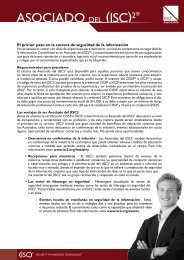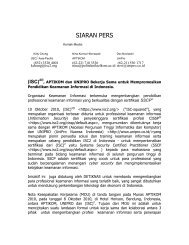Code (In)Security - ISC
Code (In)Security - ISC
Code (In)Security - ISC
You also want an ePaper? Increase the reach of your titles
YUMPU automatically turns print PDFs into web optimized ePapers that Google loves.
The absence of a catch-all exception-handling routine, and merely<br />
bubbling the raw exception information to the front end or client, is<br />
another example of improper exception or error handling. When an<br />
exception is caught, the code must handle the exception explicitly.<br />
Additionally, in the event of failure, assets should not be put at risk,<br />
which is the principle of fail-safe or fail-secure. Decisions must be<br />
based on explicit permissions instead of exclusions.<br />
It is important to ensure that errors and exceptions are handled so<br />
that they are non-verbose, do not reveal more information than is<br />
necessary, and do not violate the principles of fail-safe or fail-secure.<br />
C – Cryptographically Weak <strong>Code</strong><br />
Developers are essentially creative problem solvers who use<br />
their skills and technological know-how to create solutions to<br />
solve business problems and needs. Developers seek to improve<br />
existing functionality. Unfortunately, this has been known to<br />
backfire, especially in the context of cryptography, as evidenced by<br />
the various poor custom cryptography implementations observed<br />
in code reviews.<br />
Such reviews reveal that cryptographic functionality in code is,<br />
more often than not, custom-developed, rather than developed<br />
by leveraging existing proven and validated standard cryptographic<br />
algorithms. This contradicts the secure design principle of<br />
“leveraging existing components” to minimize the attack surface.<br />
Additionally even when proven cryptographic algorithms are<br />
used, implementation detail have been found to be insecure.<br />
Cryptography algorithms use a secret value, known as a key,<br />
to encrypt (convert plain text to cipher text) and decrypt<br />
(convert cipher text to plain text). The key to the strength of a<br />
cryptographic implementation is not necessarily the strength of<br />
the algorithm itself, but the way the key is derived and managed.<br />
Using non-random numbers to derive the cryptographic keys<br />
renders the cryptographic protection weak and ineffective.<br />
Sometimes ASCII passwords that are easily guessable and nonrandom<br />
are used to derive the cryptographic key, which should<br />
be avoided. Another common problem is that keys are not stored<br />
in a secure manner. Keys have been observed to be hard-coded<br />
inline with the code. This is akin to locking your doors and leaving<br />
the keys in the lock, thus providing minimal protection if any<br />
protection at all.<br />
Special attention must be paid when choosing the algorithm<br />
to see what the exploitability of the algorithm has been. Once<br />
chosen, Random Number Generators (RNG) and Pseudo-<br />
Random Number Generators (PRNG) must be used to derive<br />
the cryptography key for encryption and decryption. Derived keys<br />
must also be stored in a secure manner.<br />
4<br />
U – Unsafe/Unused Functions and Routines in <strong>Code</strong><br />
Unsafe functions are those that have been found to be inherently<br />
dangerous. These functions were developed without necessarily<br />
taking into account the security implications. The use of these<br />
functions gives the programmer no assurance of security<br />
protection. They can result in vulnerabilities that could allow an<br />
attacker to corrupt the system’s memory and/or gain complete<br />
control over a system. One of the reasons attributable to the<br />
infamous buffer overrun attack is the use of unsafe functions in<br />
code. Several security bulletins and patches have been published<br />
to address these functions.<br />
Unsafe functions are predominantly seen in legacy and older<br />
generation programming languages. Two common examples of<br />
these functions in the C programming language are strcpy and<br />
strcat. Since these functions do not perform length/size checks<br />
(also known as bounds checking), an attacker can supply inputs<br />
of arbitrary sizes that can overflow memory buffers. Figure 4 is<br />
an example of the unsafe C function strcpy being used to copy<br />
the input data into a local memory buffer. If there is no bounds<br />
checking, and the user-supplied input has more characters than<br />
the local memory buffer can hold, the result will be an overflow<br />
of the local memory buffer.<br />
Figure 4. Use of unsafe ‘strcpy’ C function<br />
Today, software publishers of programming languages are avoiding<br />
unsafe functions in favor of safer alternatives such as the strncpy and<br />
strncat, which allow the developer to perform length/size checks.<br />
Another insecure coding construct, observed in code reviews,<br />
is the presence of unused functions where redundant code that<br />
no longer addresses any business functionality is left remaining.<br />
Changes in the business and advancements in technology and<br />
the apprehension of breaking backward compatibility are reasons<br />
unused functions might be left in the code. This increases the<br />
relative attack surface of the code.<br />
Another classic example of unused functions in code is something<br />
known as “Easter eggs”. An Easter egg in software is secretly<br />
hidden code that can result in a change of program behavior<br />
(e.g., displaying a message, playing a sound, etc.) when particular<br />
conditions (e.g., a series of mouse clicks, keystrokes, etc.) are<br />
met. Easter eggs are usually innocuous, but they also increase the<br />
attack surface of the code and hence can have potentially serious<br />
security consequences. Risk of losing customers, introducing newer<br />
bugs, and performance impacts leading to resource exhaustions,<br />
i.e., availability impact, (along with the risk of looking like an<br />
www.isc2.org

















